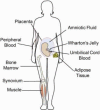Isolation, characterization, and differentiation of stem cells for cartilage regeneration
- PMID: 22907257
- PMCID: PMC3457050
- DOI: 10.1007/s10439-012-0639-8
Isolation, characterization, and differentiation of stem cells for cartilage regeneration
Abstract
The goal of tissue engineering is to create a functional replacement for tissues damaged by injury or disease. In many cases, impaired tissues cannot provide viable cells, leading to the investigation of stem cells as a possible alternative. Cartilage, in particular, may benefit from the use of stem cells since the tissue has low cellularity and cannot effectively repair itself. To address this need, researchers are investigating the chondrogenic capabilities of several multipotent stem cell sources, including adult and extra-embryonic mesenchymal stem cells (MSCs), embryonic stem cells (ESCs), and induced pluripotent stem cells (iPSCs). Comparative studies indicate that each cell type has advantages and disadvantages, and while direct comparisons are difficult to make, published data suggest some sources may be more promising for cartilage regeneration than others. In this review, we identify current approaches for isolating and chondrogenically differentiating MSCs from bone marrow, fat, synovium, muscle, and peripheral blood, as well as cells from extra-embryonic tissues, ESCs, and iPSCs. Additionally, we assess chondrogenic induction with growth factors, identifying standard cocktails used for each stem cell type. Cell-only (pellet) and scaffold-based studies are also included, as is a discussion of in vivo results.
Figures


Similar articles
-
Chondrogenic Progenitor Cells Exhibit Superiority Over Mesenchymal Stem Cells and Chondrocytes in Platelet-Rich Plasma Scaffold-Based Cartilage Regeneration.Am J Sports Med. 2019 Jul;47(9):2200-2215. doi: 10.1177/0363546519854219. Epub 2019 Jun 13. Am J Sports Med. 2019. PMID: 31194571
-
Induced pluripotent stem cells in cartilage tissue engineering: a literature review.Biosci Rep. 2024 May 29;44(5):BSR20232102. doi: 10.1042/BSR20232102. Biosci Rep. 2024. PMID: 38563479 Free PMC article. Review.
-
Synovium-derived stem cells: a tissue-specific stem cell for cartilage engineering and regeneration.Tissue Eng Part B Rev. 2012 Aug;18(4):301-11. doi: 10.1089/ten.TEB.2012.0002. Epub 2012 Apr 19. Tissue Eng Part B Rev. 2012. PMID: 22429320 Review.
-
Synergistic effects on mesenchymal stem cell-based cartilage regeneration by chondrogenic preconditioning and mechanical stimulation.Stem Cell Res Ther. 2017 Oct 3;8(1):221. doi: 10.1186/s13287-017-0672-5. Stem Cell Res Ther. 2017. PMID: 28974254 Free PMC article.
-
Chondrogenesis of mesenchymal stem cells: role of tissue source and inducing factors.Stem Cell Res Ther. 2010 Oct 13;1(4):31. doi: 10.1186/scrt31. Stem Cell Res Ther. 2010. PMID: 20959030 Free PMC article. Review.
Cited by
-
Remission of collagen-induced arthritis through combination therapy of microfracture and transplantation of thermogel-encapsulated bone marrow mesenchymal stem cells.PLoS One. 2015 Mar 16;10(3):e0120596. doi: 10.1371/journal.pone.0120596. eCollection 2015. PLoS One. 2015. PMID: 25774788 Free PMC article.
-
The Use of Allogenic Stromal Vascular Fraction (SVF) Cells in Degenerative Joint Disease of the Spine in Dogs.In Vivo. 2019 Jul-Aug;33(4):1109-1117. doi: 10.21873/invivo.11580. In Vivo. 2019. PMID: 31280199 Free PMC article.
-
Mesenchymal or Maintenance Stem Cell & Understanding Their Role in Osteoarthritis of the Knee Joint: A Review Article.Arch Bone Jt Surg. 2020 Sep;8(5):560-569. doi: 10.22038/abjs.2020.42536.2155. Arch Bone Jt Surg. 2020. PMID: 33088856 Free PMC article. Review.
-
The Good the Bad and the Ugly of Glycosaminoglycans in Tissue Engineering Applications.Pharmaceuticals (Basel). 2017 Jun 13;10(2):54. doi: 10.3390/ph10020054. Pharmaceuticals (Basel). 2017. PMID: 28608822 Free PMC article. Review.
-
A practical way to prepare primer human chondrocyte culture.J Orthop. 2016 Apr 1;13(3):162-7. doi: 10.1016/j.jor.2016.03.008. eCollection 2016 Sep. J Orthop. 2016. PMID: 27408489 Free PMC article.
References
-
- Afizah H, Yang Z, Hui JH, Ouyang HW, Lee EH. A comparison between the chondrogenic potential of human bone marrow stem cells (BMSCs) and adipose-derived stem cells (ADSCs) taken from the same donors. Tissue Eng. 2007;13:659–666. - PubMed
-
- Ahmed TA, Giulivi A, Griffith M, Hincke M. Fibrin glues in combination with mesenchymal stem cells to develop a tissue-engineered cartilage substitute. Tissue engineering. Part A. 2011;17:323–335. - PubMed
-
- Aicher WK, Buhring HJ, Hart M, Rolauffs B, Badke A, Klein G. Regeneration of cartilage and bone by defined subsets of mesenchymal stromal cells--potential and pitfalls. Adv Drug Deliv Rev. 2011;63:342–351. - PubMed
-
- Al Battah F, De Kock J, Ramboer E, Heymans A, Vanhaecke T, Rogiers V, Snykers S. Evaluation of the multipotent character of human adipose tissue-derived stem cells isolated by Ficoll gradient centrifugation and red blood cell lysis treatment. Toxicology in vitro : an international journal published in association with BIBRA. 2011;25:1224–1230. - PubMed
Publication types
MeSH terms
Grants and funding
LinkOut - more resources
Full Text Sources
Other Literature Sources
Medical

